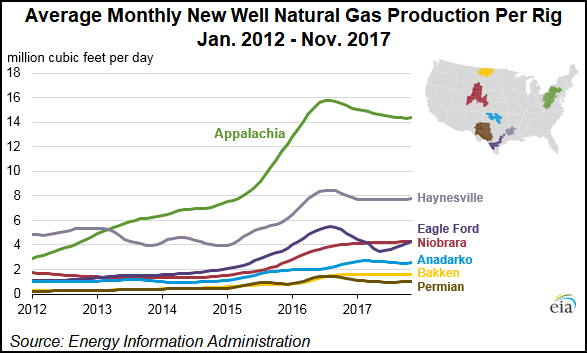Utica Shale | E&P | Marcellus | NGI All News Access
EIA Says Appalachia Continues Driving U.S. NatGas Growth
Natural gas production in the Appalachian Basin has increased by more than 14 Bcf/d since 2012, helping to drive an overall increase in U.S. volumes, the Energy Information Administration (EIA) said in a note on Monday.

According to the agency’s Drilling Productivity Report (DPR), Appalachian production primarily from the Marcellus and Utica shales grew from 7.8 Bcf/d five years ago to 22.1 Bcf/d in 2016. The basin produced 23.8 Bcf/d this year, according to EIA data through October.
The average monthly natural gas production per rig for new wells in Appalachia has increased by 10.8 MMcf/d since January 2012. The EIA attributed the sharp increases to efficiency improvements in horizontal drilling and completion techniques in the region, including faster drilling, longer laterals, better technology and improved well targeting.
In West Virginia, for example, EIA said the average lateral length per well rose from 2,500 feet in 2007 to more than 7,000 feet in 2016. More recently, some operators have recorded lateral lengths as long as 15,000 feet in Appalachia and more than 19,000 feet in the Utica Shale. The time it takes to complete a well, EIA added, decreased from about 30 days in 2011 to seven days in 2015.
As of November, EIA said 1,800 wells have been drilled in the Utica, and more than 11,300 wells have been drilled in the Marcellus.
The EIA expects U.S. dry natural gas production to average 73.4 Bcf/d this year, a 0.6 Bcf/d increase from 2016, when dry gas production fell for the first time since 2005. Natural gas production in 2018 is forecast to be 5.5 Bcf/d higher than this year’s level, according to the agency’s latest Short-Term Energy Outlook.
In its latest DPR, EIA said it expects natural gas and oil production from the nation’s seven most prolific onshore unconventional plays to increase by an estimated 1.3% this month compared to last, which would mark the 12th straight increase.
© 2024 Natural Gas Intelligence. All rights reserved.
ISSN © 2577-9877 | ISSN © 2158-8023 |
